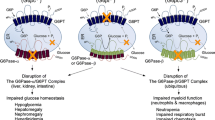Abstract.
Thirty-three years after Von Gierke described the first patient with glycogen storage disease type 1 (GSD1) in 1929, the Coris detected glucose-6-phosphatase (G6Pase) deficiency. The first mutation of this enzyme was identified 41 years later and subsequently the gene was mapped to chromosome 17q21, its enzyme topology defined, a nine transmembrane helical model suggested, an enzyme deficient knockout mouse created and by infusing an adenoviral vector associated murine G6Pase gene, correction of the clinical and laboratory abnormalities was observed. A similar successful gene transfer has been performed in enzyme deficient canine puppies. To explain the function of the G6Pase complex, a multicomponent translocase catalytic model has been proposed in which different transporters shuttle glucose-6-phosphate (G6P), inorganic phosphate (Pi) and glucose across the microsomal membrane. It was suggested that GSD1b patients suffered from a G6P transporter (G6PT) defect and the first mutation in the G6PT gene subsequently recognised. The gene mapped to chromosome 11q23 and its structural organisation was defined which showed a close functional linkage between G6PT and hydrolysis. Nordlie identified the first patient with Pi transport deficiency (GSD1c). However putative GSD1c and 1d patients based on kinetic studies were found to harbour mutations in the G6PT gene so that GSD1 patients are presently divided into 1a and non-1a. G6PT deficient patients suffer from numerical and functional leucocyte defects. A mRNA leucocyte G6PT deficiency has been suggested to account for the glucose phosphorylation and subsequent calcium sequestration defects observed in theses cells. Inflammatory bowel disease which occurs frequently in GSD non-1a patients has been related to their leucocyte abnormalities. Dietary management of GSD1 patients, designed to maintain a normal blood glucose level can be achieved during the night by nocturnal gastric infusions of glucose-containing solution or by the administration of uncooked cornstarch around the clock or by a combination of both. Both therapeutic modalities, if conducted in a meticulous manner, have a major impact on the quality of life, prevention of complications and subsequent prognosis. Open questions relate to the source of endogenous glucose production in GSD1 patients which increases as a function of age from 50% to 100% of normal, concomitant with an improvement in the patients fasting tolerance. Several complications, the nature of which is incompletely understood, tend to occur after the first decade: Liver adenomata with a small risk of transforming into hepatoma, progressive renal disease, which may be related to the hyperlipidaemia observed in this disease, often leading to end stage renal failure, osteopenia apparently based on high bone turnover, growth retardation and delayed puberty. Conclusion: this review highlights the present knowledge of glycogen storage disease type 1 and subtypes, discussing unsolved questions, which reflect the limitation of our knowledge in the understanding of this intriguing group of diseases.
Similar content being viewed by others
Author information
Authors and Affiliations
Additional information
Electronic Publication
Rights and permissions
About this article
Cite this article
Moses, S.W. Historical highlights and unsolved problems in glycogen storage disease type 1. Eur J Pediatr 161 (Suppl 1), S2–S9 (2002). https://doi.org/10.1007/s00431-002-0997-6
Issue Date:
DOI: https://doi.org/10.1007/s00431-002-0997-6




